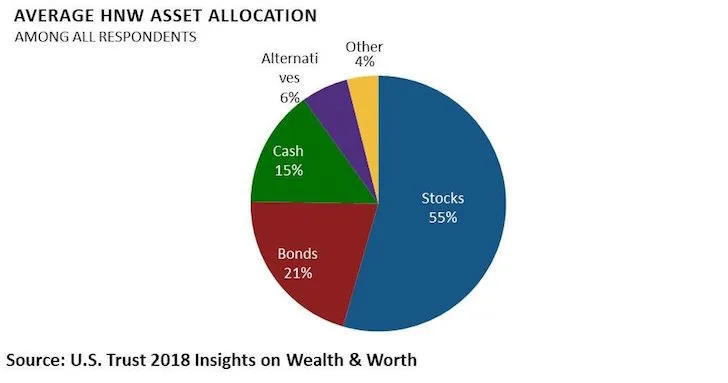Many people know that real estate can generate great returns but don’t know how much of their portfolio they should allocate toward this lucrative asset class. After all, traditional investing advice tends to focus only on stocks and bonds.
So in this article, we’ll dive into what an appropriate asset allocation looks like when it comes to real estate (especially single-family homes) and more.
Contents
Factors to Consider During Asset Allocation
First, it’s important to clarify that we are not counting your primary residence as part of your investment portfolio. Though your home can appreciate in value, its main purpose is to provide utility (i.e. shelter) now. For that reason, you should exclude your primary residence from any asset allocation calculations.

Your investment portfolio can include stocks, bonds, commercial real estate, single family real estate and other alternative investments like private equity, hedge funds, venture capital, art, and collectibles.
How much of each asset class makes up in your overall portfolio depends on many factors, including your risk tolerance, time horizon, target retirement date, and more. It also depends on what your short- and long-term investing goals are in the first place.
So there is not one “right” answer to how much of your portfolio you should invest in real estate. However, there are some guidelines that may help.
How Much the Wealthy Allocate Toward Real Estate
Investing expert Barbara Friedberg says a real estate allocation of 5% to 10% is a good rule of thumb since real estate is an alternative asset class.
At the same time, private equity and real estate investor and serial entrepreneur Ian Ippolito recommends putting as much as 13 to 26% or more into real estate. He cites a 2017 study, which shows that unleveraged residential properties return more than stocks with less risk. He also points out that the Yale Endowment (which consistently beats the market) allocates as much as 20% of its portfolio to real estate.

In fact, the Yale Endowment’s Chief Endowment Officer David Swensen recommends that investors who want a “well-diversified, equity-oriented portfolio” allocate 20% of their portfolio to real estate investment trusts.
Other institutional investors make similar recommendations. For example, Blackstone and Baird both emphasize the importance of allocating a significant portion of your portfolio to alternative investments like real estate.
So if you want to invest as the wealthy do, you might consider allocating about 20% of your portfolio to real estate.
Benefits of Investing in (Single-Family) Real Estate
That said, what makes real estate such an attractive asset class to expert investors? On top of the competitive returns, real estate offers many benefits not found in most other alternative assets. Here are a few of them:
- A hedge against inflation. Property owners can hedge against inflation by transferring inflationary pressure onto tenants in the form of higher rent.
- No (or negative) correlation with the stock market. Real estate values don’t follow stock prices (but that doesn’t mean there isn’t some correlation between stocks and real estate). So by having some of your portfolio in real estate, your investments are more protected against market downturns via diversification.
- Recurring income. On top of value appreciation, real estate can generate steady rental income from rental properties. So even if the value of a property fluctuates, you’ll still benefit from recurring monthly rent payments.
- Tax benefits. Real estate is one of the most tax-advantaged asset classes out there. For example, you can write off common property expenses like home insurance, repairs, and maintenance as well as the property’s depreciation. You can also defer capital gains taxes indefinitely through 1031 exchanges.
- Tangible asset. Unlike many assets, a real estate portfolio is tangible, which means it has real practical value. So even if its financial value drops to zero, it can still be used as a place to live or operate a business.
- Leverage. If you were to go to a bank and ask for a loan to invest in stocks or mutual funds, you’d get funny looks and your request would be denied. But if you ask for a loan to invest in a property, that’s called a mortgage and banks offer them all the time. It means you can put down 20% of the loan value but reap the rewards for 100% of the property value. Few (if any) other asset classes are like this.
- Low volatility. Real estate investments are much less volatile than the stock market. Since 1963, housing prices have only dipped by more than 10% once (during the 2008 housing crash). On top of that, rents are particularly stable and drop even less frequently.
- More control. When you own investment property, you have much more control over the asset. You can decide when to make improvements, what property manager to hire, and who to rent to. All these decisions serve as levers that you can adjust to improve the asset’s performance. Greater control is available through some unique structures, including self-directed IRA investing in turnkey real estate.
- Stable demand. There will always be demand for real estate so long as people need somewhere to live and work. So even if the demand fluctuates, you never have to worry about demand dropping to zero, the way demand for a particular stock can.
Start Investing in Single-Family Real Estate
If you’re ready to start investing in real estate, there are a few different ways you can do it. You can either buy an investment property on your own, invest in a real estate investment trust (REIT), or invest in a real estate fund like the Invest.net SFR Fund I.
Buying and managing your own investment property can be a lot of work and is the least diversified approach. It’s putting a lot of your eggs in one basket.
REITs have been around since the 1960s and are one of the easiest and cheapest ways to invest in real estate. However, they also offer the least amount of control.
Finally, a real estate fund or real estate investment group (REIG) offers investors the best of both worlds. You get the diversification of investing in multiple properties across the U.S. while also being able to pick funds tailored to your investment needs and strategy.
Interested in learning more? Contact us today to learn more about our single-family real estate investment offerings. We look forward to chatting with you!
- 10 Real Estate Investment Exit Strategies To Consider - November 2, 2023
- Investing in Residential vs. Commercial Real Estate: Which Is Better? - September 6, 2023
- What Is Private Equity Real Estate Investing? - April 4, 2023

